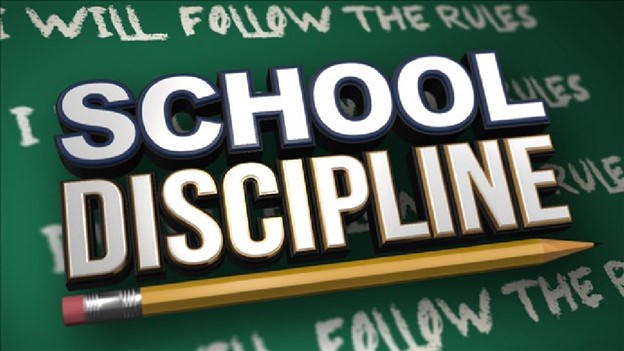Submitted by John Arbeeny.

At the 10 January 2022 Clover Park School Board meeting Director David Anderson made motion “that the school Board have on its regular agenda, as soon as time for relevant reports are prepared, the subject of school discipline.” The motion, seconded by Director Paul Wagemann, was passed unanimously by the Board.
This article is a preliminary analysis of disciplinary issues within the Clover Park School District by school year, school, race, and offenses.
During door-belling thousands of homes in the last Clover Park school board campaign oft heard were complaints from the public, to include District teachers and staff, about school discipline.
An examination of 123 individual Board meeting minutes back to 2017 failed to reveal a single Board meeting that addressed the topic of District discipline comprehensively.
A Freedom of Information Act (FOIA) request 21-103 to Clover Park School District resulted in an Excel spreadsheet that allowed analysis of discipline data 2017-2021.
The figures presented may represent only the tip of the iceberg as is the case in policing where less than 50% of even serious crimes go unreported and half of those reported are actually solved.
The FOIA request contained 36,118 instances on 1,063 pages of disciplinary offenses over the last 5 years. Below are the numbers of disciplinary offenses by year. The school year has been calculated at 180 days.
BY SCHOOL YEAR
- 2017 – 10,570 offenses, 29%, 59 offenses daily.
- 2018 – 11,426 offenses, 32%, 63 offenses daily.
- 2019 – 9,829 offenses, 27%, 55 offenses daily.
- 2020 – 3,113 offenses, 9%. Covid shut schools down in March 2020 through September, 2021.
- 2021 – 1,180 offenses, 3%. From September 1, 2021, with data provided ending November 23, 2021.
Using data for September-November 2017 -2019 the number of disciplinary offenses averaged 3,460 for that three month period during those three years. Yet the number of disciplinary issues for September – November 2021 was only 1,080, a drop 71%. This drop may be linked to elimination of “zero tolerance discipline” supported by the District and OSPI.
“Zero tolerance discipline” is essentially the reporting and disciplining each and every infraction regardless of race or ethnicity. Ending “zero tolerance discipline” would instead view disciplinary offenses through the “lens of equity” which is to say race or ethnicity of the offender: discipline on a “curve” of sorts.
When you fail to report disciplinary offenses, the offense rate goes down! The ending of “zero tolerance discipline” is supported by the District, the Clover Park Association of School Principals (CPASP) and directed by the Office of the Secretary of Public Instruction (OSPI). Whether a “kinder, gentler” approach to discipline based upon race or ethnicity reduces disciplinary offenses remains to be seen but if criminality trends in the general populace are any indication I suspect not.
Here are the 36,118 disciplinary offenses between 2017 and 2021 broken out by school with the percentage of the total offenses and student population.
BY SPECIFIC SCHOOL
- CPHS: 8,545 (23%) (1,283 students)
- Lakes HS: 5,666 (16%) (1,295 students)
- Harrison: 661 (2%) (Includes ages both in middle and high school) (713 students)
- Hudtloff: 7,320 (20%) (744 students)
- Lochburn: 6,507 (18%) (626 students)
- Mann/Woodbrook/Thomas (consolidated) 2,886 (8%) (508 students)
- All elementary schools (21) combined: 4,533 (13%) (6,696 students)
Eighty-five (85%) percent of disciplinary offenses are concentrated in just five schools: CPHS, Lakes, Hudtloff, Lochburn and Dr. Thomas.
Surprisingly Hudtloff and Lochburn have far higher offense rates per student population than either of the District’s high schools. These middle schools represent a huge jump in disciplinary offenses (about 15 times!) compared to the elementary schools from which their students came.
There may be several causes: new school environment, rebellious “tweens” and uncertainty about the vision and future direction of their academic life (“what do I want to be when I grow up”). Perhaps middle schools are where our attention needs to be focused when it comes to discipline and individual educational plans to give otherwise restless children something to focus upon: a vision of their future.
Harrison Prep and the remaining 21 elementary schools have combined offense levels far below the “top 5” given their student populations. Thus, the total of 36,118 offenses cannot be simply averaged across the District’s 27 schools but must be addressed individually by school.
CPHS has the greatest number of disciplinary offenses reported (8,545/23%) while Lakes HS has significantly fewer by 34% (5,666/16%) assuming the same reporting criteria and their similar student populations.
It is of note that these high schools also have a significant disparity in academic performance with CPHS significantly underperforming Lakes HS. Whether this disparity in disciplinary offenses and academic performance is linked to causality or merely coincidence is beyond the scope of this analysis but should be investigated further.
A safer learning environment would seem to provide a better learning environment and chance to achieve academic excellence.
Here are the 36,118 disciplinary offenses between 2017 and 2021 broken out by race and ethnicity, number of offences, percentage of total offenses, percentage of population (%) and whether under or over represented.
BY RACE/ETHNICTY
- Native Americans: 194, .54%. Less than 1% of population. Underrepresented.
- Asians: 629, 2%, comprising 5.2% of population. Underrepresented.
- Black: 8,548, 24%, comprising 11.1% of population. Overrepresented.
- Hispanic: 10,695, 30%, comprising 45.8% of population. Underrepresented.
- Pacific Islander/Hawaiian: 1,860, 5%, comprising 8.1% of population. Underrepresented.
- Mixed race: 5,849, 16%, comprising 11.2% of population. Overrepresented.
- White: 8,339, 23%, comprising 18.2 of population. Overrepresented.
There is a significant disparity between racial and ethnic groups with respect to their population percentages in the District but not what might be expected. Blacks, whites and mixed race individuals are over represented in disciplinary offenses, while Native Americans, Asians, Hispanic and Pacific Islanders are under- represented. There may be other underlying causes of these disparities more important than the individual’s race or ethnicity. Socio-economic factors as well as family structure and values may have a greater impact on behavior than merely skin color or family origin.
The important take away from these statistics is that “membership” in a racial or ethnic majority or minority has little to do with whether that “group” is overrepresented or underrepresented or whether individuals within the group are likely to offend or not. There are too many other factors for each individual involved to merely use race or ethnicity as the “equity lens” in addressing discipline.
These statistics by race and ethnicity would seem to question ending “zero tolerance”.
Discipline based upon race or ethnicity may be misguided for ascribing to race or ethnicity a particular propensity to offend or not to offend: both black and white are over represented here.
For those “beneficiaries” of ending “zero tolerance discipline”, have we not also created the false expectation that race or ethnicity will be a prime consideration in the criminal justice system outside the classroom?
Here are the 36,118 disciplinary offenses between 2017 and 2021 broken out below by specific offense. The offense code is immediately followed by the number of associated offenses that occurred. The number following the Offense Description (i.e. 3203) is the District policy number that pertains to the offense.
It appears that about 28,920 (80%) of the disciplinary offenses are related to defiance of school authority, lower level offenses handled by teachers, disruptive behavior, cellular phones, foul language, cheating, truancy, etc. Although not potentially criminal they do have an impact upon the classroom environment and affect student learning for both the offender and classmates.
There were about 7,198 (20%) potentially criminal incidents including assault, weapons, drugs, marijuana, arson, gang affiliation, theft, vandalism, communicating threats, sexual harassment and “HIB” (harassment, intimidation, bullying ) signified by an asterisk*.
OFFENSE CODE AND OFFENSE DESCRIPTION
- ALC 112* Alcohol – 3202 P1
- ALT 15 Alteration of Records – 3240 P1
- ARS 36* Arson – 3300 P1
- AST 1633* Assault – 3240 P1
- CHE 279 Cheating – 3240 P1
- COO 4543 Cooperation with School Staff – 3240 P1 (defiance of school authority)
- CRI 13* Criminal Acts – 3202
- DC 9238 Disruptive Conduct – 3240
- DOC 3256 Documentation (Discipline by teacher not brought to administration level)
- DRE 187 Repeat Dress Violation – 3200P12
- DRU 168* Illicit Drugs – 3240 P1
- ELE 3123 Electronics (cellular phone)
- EMC 942* Exceptional Misconduct – 3300
- FIG 1943* Fighting without injury – 3300 P1
- GAN 22* Gang Affiliation – 3201
- HAN 3* Handgun – 3233
- HAZ 0 Hazing/Initiations – 3200 P6
- HIB 533* HIB – 3207
- HID 4* HIB/Basis of Disability
- HIE 5* HIB/Basis of Religion
- HIG 8* HIB/Basis of Gender
- HIR 60* HIB/Basis of Race
- HIS 69* HIB/Basis of Sexual Orientation
- INT 7 Interference – 3200 P5
- KNI 99* Knife/Dagger – 3233
- LC 352 Leaving Campus without permission – 3151
- LOP 450 Lewd, Obscene, Profane Language/Gesture/Material
- MAR 255* Marijuana
- MF 0 Multiple Firearms – 3233
- ODR 859 Office Dis Referral
- OF 5* Other Firearms – 3233
- OTH 1502 Other
- OW 43* Other weapons – 3233
- PRF 675 Profanity and Vulgarity – 3200 P7
- PRO 0 Prohibited Orgs – 3200 P8
- QP 0 BECCA requested by parent
- QS 5 BECCA requested by school
- RIF 0 Rifle/Shotgun – 3233
- SB 0 Serious Bodily Injury
- SH 164* Sexual Harassment – 3244
- THE 162* Theft of Property – 3300 P1
- THR 584* Threats of Violence/Harm – 3305
- TOB 82* Tobacco – 3200 P9
- TRE 2* Trespass on School Property – 3160
- TRU 4014 Truancy/Attendance – 3122
- VAN 146* Vandalism – 3122
- VIO 415 Repeat School Violations – 3200 P11
- VW 72* Violence with Injury – 3300 P1
- VWO 33* Violence without Injury – 3300 P1
Consider CPHS as an example to understand the seriousness of discipline and criminality.
CPHS averaged 23% of all offenses in 2017. If 59 offenses occurred daily District-wide during 2017, then CPHS accounts for 14 offenses daily for a total of 2,520 annually. If 20% of those annual 2,520 CPHS offenses are potentially criminal, that equates to 504 criminal offenses annually.
There are 1,283 students in CPHS which means the potential crime rate is 504 potential criminal events to 1,283 students or 39%. Compare this to the crime rate for Lakewood’s general population of 47 per 1,000: 4.7%.
Thus, the criminal offense rate at CPHS is potentially 8+ times greater than that in Lakewood’s general population! Imagine living in a city with that kind of crime problem: our student children and their teachers do every day!
Discipline is a serious issue. For every student affected by a single disciplinary offense and particularly a criminal offense, there is a circle of family, friends and acquaintances that are affected. Multiply this by the number of all offenses, not just reported offenses, and you have the potential of widespread anxiety, distraction, disruption and psychological impacts upon students, their learning environment and academic performance.
This is an issue that deserves the Board and District’s immediate attention.
Source: The Suburban Times









Recent Comments